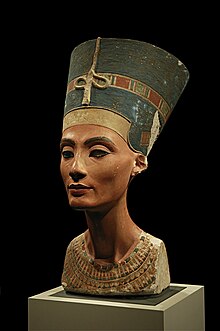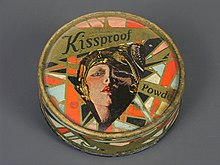
cosmetic products
Index
Index
Definition and etymology[edit]
A bust of the Egyptian queen Nefertiti showing the use of eye liner made of kohl
An 1889 Henri de Toulouse-Lautrec painting of a woman applying facial cosmetics
Kissproof brand face powder from 1926, from the permanent collection of the Museo del Objeto del Objeto in Mexico City
The word cosmetics derives from the Greek κοσμητικὴ τέχνη ("kosmetikē tekhnē"), meaning "technique of dress and ornament", from κοσμητικός ("kosmētikos"), "skilled in ordering or arranging"[2] and that from κόσμος ("kosmos"), meaning "order" and "ornament".[3] Cosmetics are constituted from a mixture of chemical compounds derived from either natural sources, or synthetically created ones.[1]
Legal definition[edit]
|
|
The examples and perspective in this section may not represent a worldwide view of the subject. You may improve this section, discuss the issue on the talk page, or create a new section, as appropriate. (August 2021) (Learn how and when to remove this template message) |
Though the legal definition of cosmetics in most countries is broader, in some Western countries, cosmetics are commonly taken to mean only makeup products, such as lipstick, mascara, eye shadow, foundation, blush, highlighter, bronzer, and several other product types.
In the United States, the Food and Drug Administration (FDA), which regulates cosmetics,[4] defines cosmetics as products "intended to be applied to the human body for cleansing, beautifying, promoting attractiveness, or altering the appearance without affecting the body's structure or functions". This broad definition includes any material intended for use as an ingredient of a cosmetic product, with the FDA specifically excluding pure soap from this category.[5]
Use
Cosmetics designed for skin care can be used to cleanse, exfoliate and protect the skin, as well as replenishing it, through the use of cleansers, toners, serums, moisturizers, and balms. Cosmetics designed for more general personal care, such as shampoo and body wash, can be used to cleanse the body.
Cosmetics designed to enhance one's appearance (makeup) can be used to conceal blemishes, enhance one's natural features (such as the eyebrows and eyelashes), add color to a person's face and—in the case of more extreme forms of makeup used for performances, fashion shows and people in costume—can be used to change the appearance of the face entirely to resemble a different person, creature or object. Techniques for changing appearance include contouring, which aims to give shape to an area of the face.
Cosmetics can also be designed to add fragrance to the body.


